Fake Krist, born 01-01-1904, in Beilen,  Netherlands, to Jan Krist and Pietertje, born Smelt, worked for the Haarlem police since 1932. Krist was a member of the Dutch NSB. The National Socialist Movement in the Netherlands (NSB)
Netherlands, to Jan Krist and Pietertje, born Smelt, worked for the Haarlem police since 1932. Krist was a member of the Dutch NSB. The National Socialist Movement in the Netherlands (NSB)  under command of Anton Adrian “Ad” Mussert
under command of Anton Adrian “Ad” Mussert



 was a Dutch political party that existed from 1931 to 1945. The NSB adhered to the ideology of Adolf Hitler‘s National Socialism, presented itself as a movement rather than a party, based on an anti-democratic attitude, and functioned as a collaboration party during the German occupation of the Netherlands in World War II.
was a Dutch political party that existed from 1931 to 1945. The NSB adhered to the ideology of Adolf Hitler‘s National Socialism, presented itself as a movement rather than a party, based on an anti-democratic attitude, and functioned as a collaboration party during the German occupation of the Netherlands in World War II.
Krist was also an associated Rechtsfront.  The Rechtsfront was founded on 12-08-1940 by the Alkmaar judge H.M, Fruin
The Rechtsfront was founded on 12-08-1940 by the Alkmaar judge H.M, Fruin  on the instructions of Mussert and was an NSB organisation. The Rechtsfront aimed to unite everyone who was involved in finding the law, applying the law and enforcing the law. The condition was that (aspiring) members had to be prepared to cooperate in the construction of a new, national socialist state, as advocated by the NSB. Technically, the Rechtsfront was divided into departments of Justice, Politics, Legal Profession, Notary, Tax Consultants and Accountants.
on the instructions of Mussert and was an NSB organisation. The Rechtsfront aimed to unite everyone who was involved in finding the law, applying the law and enforcing the law. The condition was that (aspiring) members had to be prepared to cooperate in the construction of a new, national socialist state, as advocated by the NSB. Technically, the Rechtsfront was divided into departments of Justice, Politics, Legal Profession, Notary, Tax Consultants and Accountants.
During the occupation Krist was one of the most dedicated and fanatical employees of the German Sicherheitsdienst or SD. ![]() founded by Reichsleiter Heinrich Himmler
founded by Reichsleiter Heinrich Himmler
The Sicherheitsdienst (SD) evolved between 1931 and 1945 from a modest National Socialist German Workers’ Party (NSDAP)  intelligence service into the state intelligence service of Nazi Germany with 51 main departments and 519 regional departments, several thousand agents and tens of thousands of informants.
intelligence service into the state intelligence service of Nazi Germany with 51 main departments and 519 regional departments, several thousand agents and tens of thousands of informants.
Krist was very successful in tracking down Jews, people in hiding and resistance fighters. In 1944 he arrested 26 people in one night with the help of his most loyal employees. From the spring of 1944 the Haarlem resistance listened to his telephone at the police station. It gradually became clear that Krist knew the names of many people in hiding and resistance fighters that he still wanted to arrest. In 1944, with the help of his most loyal associates, he arrested 26 people in one night. On 22-07-1944, he arrested Rev. Bastiaan Jan Ader

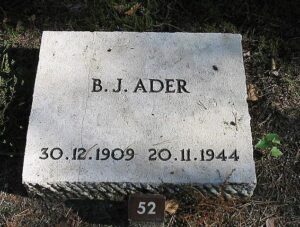
 on Pieter Kiesstraat, thereby (unknowingly) foiling a plan to liberate concentration camp prisoners from Westerbork. In September 1944 the leadership of the resistance in Haarlem and the surrounding area decided that this dangerous traitor had to be liquidated. On Mad Tuesday, September 5, the Council of Resistance (RVV) made a first attempt to kill Krist. But he had spotted his attacker, Otto de Ronde, and managed to escape. An attack that same day on Krist’s employee Harm Smit, carried out by RVV members Truus Oversteegen
on Pieter Kiesstraat, thereby (unknowingly) foiling a plan to liberate concentration camp prisoners from Westerbork. In September 1944 the leadership of the resistance in Haarlem and the surrounding area decided that this dangerous traitor had to be liquidated. On Mad Tuesday, September 5, the Council of Resistance (RVV) made a first attempt to kill Krist. But he had spotted his attacker, Otto de Ronde, and managed to escape. An attack that same day on Krist’s employee Harm Smit, carried out by RVV members Truus Oversteegen 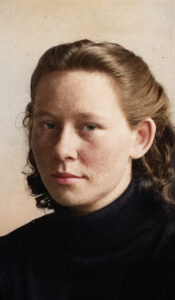 and Jan Heusdens,
and Jan Heusdens,  did succeed. After that, a gang of thugs operating from Stoop’s bath made two more attempts to capture Fake Krist, but they failed due to bad luck. Bastiaan Jan Ader also did a lot of resistance work outside his own municipality. When he was on his way in Haarlem on 22-07-1944, he was arrested and locked up in Haarlem and soon after transferred to the prison on the Weteringschans in Amsterdam. As a reprisal for an attack on a German soldier, he was executed at the age of 34 near Veenendaal and initially buried there. After the war, a white cross was placed at the execution site, which was renewed on the seventieth anniversary of the event. An annual commemoration takes place at Het Kruis op de Berg on 20 November. After the war, Ader’s remains were transferred to the Loenen Field of Honour.
did succeed. After that, a gang of thugs operating from Stoop’s bath made two more attempts to capture Fake Krist, but they failed due to bad luck. Bastiaan Jan Ader also did a lot of resistance work outside his own municipality. When he was on his way in Haarlem on 22-07-1944, he was arrested and locked up in Haarlem and soon after transferred to the prison on the Weteringschans in Amsterdam. As a reprisal for an attack on a German soldier, he was executed at the age of 34 near Veenendaal and initially buried there. After the war, a white cross was placed at the execution site, which was renewed on the seventieth anniversary of the event. An annual commemoration takes place at Het Kruis op de Berg on 20 November. After the war, Ader’s remains were transferred to the Loenen Field of Honour.
In the early morning of 25-10-1944, three men entered the school. Gommert Krijger pseudonym Black Kees,  Jan Overzet
Jan Overzet 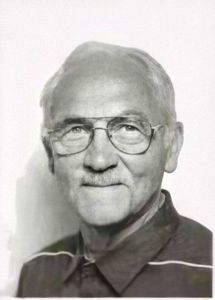 and Nico Sikkel
and Nico Sikkel 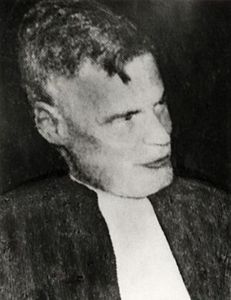 They went to the gym on the first floor and waited. In order to be able to shoot, they had broken a window. Completely unexpectedly, the school caretaker suddenly entered the room. He was tied up. Jan Overzet: “Just after half past eight, Krist arrived on his bike. He was in uniform and had a carbine on his back. (…). I gave Krijger a sign, because he didn’t know Krist. The distance between us and Krist was about 40, 50 metres.” Krijger took aim and probably shot four times. The first shot bounced off the Sint Bavo. Shards of stone injured the young Gerard Strik who had just come outside. The other shots ended Krist’s life. His guard was unable to do anything. The resistance fighters managed to escape before the Germans cordoned off the area.
They went to the gym on the first floor and waited. In order to be able to shoot, they had broken a window. Completely unexpectedly, the school caretaker suddenly entered the room. He was tied up. Jan Overzet: “Just after half past eight, Krist arrived on his bike. He was in uniform and had a carbine on his back. (…). I gave Krijger a sign, because he didn’t know Krist. The distance between us and Krist was about 40, 50 metres.” Krijger took aim and probably shot four times. The first shot bounced off the Sint Bavo. Shards of stone injured the young Gerard Strik who had just come outside. The other shots ended Krist’s life. His guard was unable to do anything. The resistance fighters managed to escape before the Germans cordoned off the area.
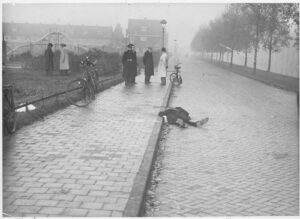
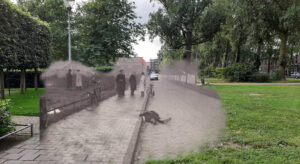
The resistance knew that Krist’s execution would not be without consequences. The Germans would take revenge for the attack on this important collaborator. That would certainly cost lives. During the last year of the war, the confrontation between the resistance and the occupier became increasingly grim. It was war, it was hard against hard. In that atmosphere, the decision had to be made. If Krist had been allowed to continue as he was, it would probably have led to the arrest and death of dozens of Jews and resistance fighters. The German revenge was not long in coming. Early in the morning of the day after the attack, two German military trucks stopped at the park behind the Sint Bavo. The civil servant Johan van Rijn saw it happen from his bedroom window. “A little later I saw five men handcuffed together jump out of one of the cars and then they were placed against the fence at the park.” A machine gun salvo rang out and the five men were dead. Five others suffered the same fate immediately afterwards. The ten men came from the prison on the Weteringschans in Amsterdam. The German lust for revenge had not yet cooled down. On the Westergracht, a block of four houses was set on fire. The residents had been chased from their homes and could not take much more than some clothes that they had hastily grabbed from the coat rack. Passers-by were forced to watch the Germans take revenge. Resistance fighter Truus Oversteegen was among them. She and others were arrested when they happened to pass by. Five men jumped out of one of the trucks, handcuffed. They were lined up in front of the fence of the park. When the rifles were put to their shoulders, an old man hesitantly began to sing the Wilhelmus, the Dutch national anthem. A machine gun salvo sounded and the men were killed. Five other men immediately suffered the same fate.
In 1949, the statue ‘Grieving Woman’ 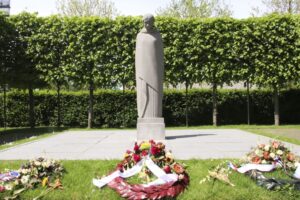 was unveiled in the park. It was made by Ludwig Oswald Wenckebach. The names of the deceased are inscribed on ten stones around the pedestal. A commemoration ceremony takes place there every year on 4 May.
was unveiled in the park. It was made by Ludwig Oswald Wenckebach. The names of the deceased are inscribed on ten stones around the pedestal. A commemoration ceremony takes place there every year on 4 May.
Fake Krist was buried by the Germans on the General Cemetery Kleverlaan, in Haarlem, Netherlands. The gravestone was engraved with a text stating that this was a cowardly murder. Later he got a new gravestone with only his name on, but people removed the text and has remained so until now, no traitors dig in Haarlem.
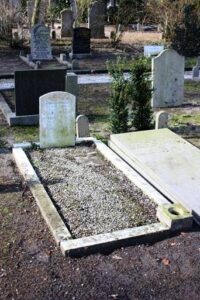




















Leave a Reply